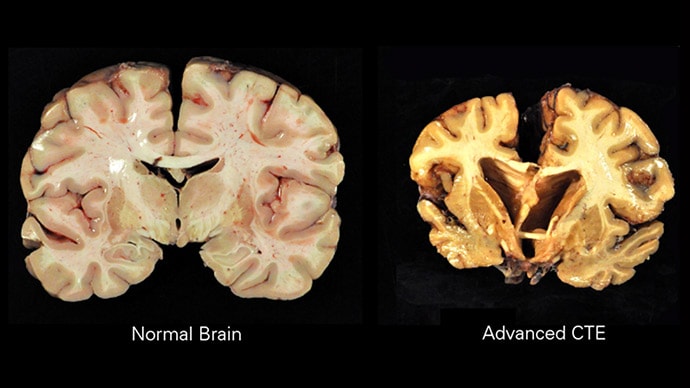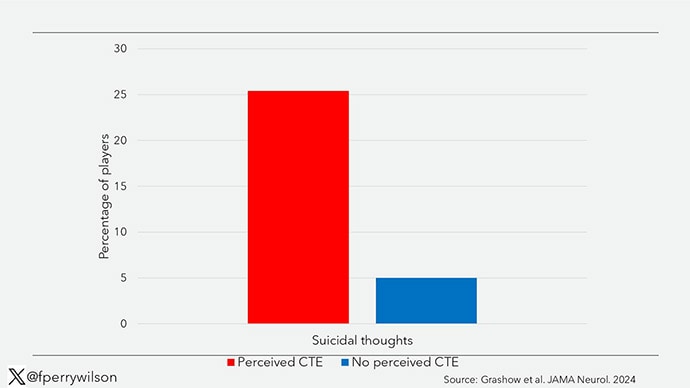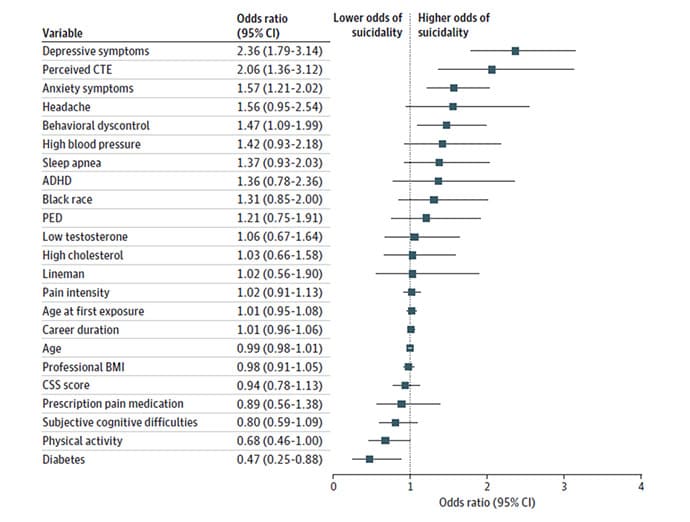Welcome to Impact Factor, your weekly dose of commentary on a new medical study. I'm Dr F. Perry Wilson of the Yale School of Medicine.
When I first learned about chronic traumatic encephalopathy (CTE) in medical school, it was in the context of professional boxers. Repeated blows to the head, we were taught, could lead to a neurologic syndrome — colloquially called "punch drunk syndrome," formally named dementia pugilistica — that was essentially impossible to treat.
But I bet if I say CTE today, you don't think of boxers. No, especially at this time of year, I imagine your brain goes to one place.
Football.
The first reports of CTE in a football player occurred in 2002, when all-star Mike Webster of the Pittsburgh Steelers and Kansas City Chiefs died of a heart attack at age 50.
CTE was discovered in his brain on autopsy. American football quickly became the poster child for the syndrome. Which is not to say that other sports don't have their cases — CTE has been reported in ice hockey players, rugby players, and more rarely, soccer players who head the ball.
As our understanding of CTE has evolved, so have the symptoms that we associate with it. We now recognize that the Parkinsonian features that were described in dementia pugilistica (think Muhammad Ali) may not be as common as the psychological ones: depression, anxiety, and suicidality.
We're also starting to understand how common the syndrome might be among professional football players. But I didn't realize how bad it might be until this week, when a study asked ex-professional American football players if they thought they had CTE. One in three said yes.
Before we dig in, I need to clarify some terms.
There is only one way to diagnose someone with CTE, and by the time you do it, the diagnosis won't be much help. That's because the way you diagnose CTE is via autopsy. It is a diagnosis that requires examination of brain tissue and is characterized by tangles of tau proteins conglomerating around the small vessels in the depths of the cortical sulci.

In the largest autopsy case series of NFL players I could find, from 2023, of 376 players who donated their brains after death, 345 had CTE. That's 92%. Of course, there may be selection bias at play here: Players who are concerned that they may have CTE may be more likely to donate their brains to science after death. Still, the prevalence is hard to ignore.
Prior to death, you can't diagnose CTE, but you can identify "traumatic encephalopathy syndrome" (TES) characterized by movement, behavioral, and mood changes in people with a history of repeated head trauma. But this is not definitive and requires ruling out all other causes of dementia first.
We simply don't have a good window into players' brains while they are alive. But they do.
That's what fascinates me so much about this study, "Perceived Chronic Traumatic Encephalopathy and Suicidality in Former Professional Football Players", appearing in JAMA Neurology.
Since 2015, researchers at Harvard have been running the Football Players Health Study, which recruits former professional football players in the US. They invited more than 15,000 to enroll, of whom 27% had enrolled by the time of the study we are talking about today. Of these, 1980 had complete data for the analysis, which focused on a simple question asked during a routine survey of these men: "Do you believe you have chronic traumatic encephalopathy (CTE)?"
And 681 out of 1980 (34.4%) said yes. That is just a staggering number.
Now, you wouldn't be wrong to say that the question itself is not exactly straightforward. No effort was made to determine whether the players knew what CTE was. And one's perception of CTE — which may be based more on media reports than medical studies — is by no means the same as having CTE or even TES.
Still, there is value to subjective experience. And what this study is telling us is that 1 in 3 ex–pro football players at least feel that their brains have been adversely affected.
There are some key differences between people who answered yes and no to that question.
People who answered yes were younger — perhaps reflecting the fact that CTE has been in the public consciousness more as time goes on. They were also more likely to be Black, to be taking prescription pain medication, and to have headaches. Numerically, they were also slightly more likely to be linemen than other positions, though this was not statistically significant.

What really shocked me was the rate of reporting suicidal thoughts. Fully 25.4% of those who thought they had CTE reported feeling suicidal at least some of the time. Compare that with 5% of those who did not think they had CTE.

These are scary numbers.
You may wonder whether the perception that you have CTE is really just a proxy for depression — and it is depression that is really driving this relationship — but it doesn't seem like it, at least not entirely.

This chart shows the relationship between risk factors on the left and suicidality in a mutually adjusted model. It shows that, sure, depression is the No. 1 risk for suicidality, but perceived CTE is the No. 2 risk, even with adjustment for the presence of depression.
What remains unknown here is whether the players are right or not. The only way to truly diagnose CTE, at least for now, is on autopsy.
But honestly, regardless of whether this self-diagnosis is accurate, the implication remains. These individuals feel something is wrong — and that wrongness puts them at higher risk for suicidal thoughts and, presumably, death from suicide. It suggests that providers caring for individuals with a risk for CTE may want to ask this question, not because of its diagnostic validity but because it is, independent of mood symptoms, a major red flag for the risk for self-harm.
F. Perry Wilson, MD, MSCE, is an associate professor of medicine and public health and director of Yale's Clinical and Translational Research Accelerator. His science communication work can be found in the Huffington Post, on NPR, and here on Medscape.
https://www.medscape.com/viewarticle/one-three-pro-football-players-think-they-have-cte-2024a1000h9j
No comments:
Post a Comment
Note: Only a member of this blog may post a comment.